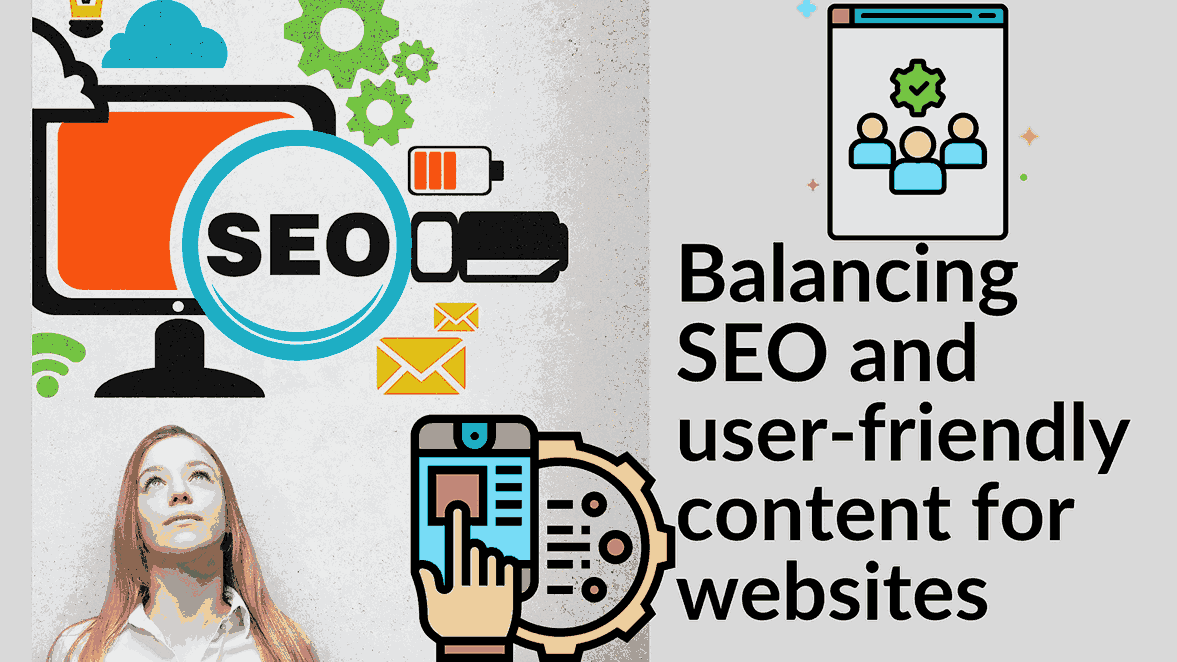Balancing SEO and user-friendly content for websites
- WebOps Platforms Bug Tracking & Feedback Software Web Development & Design


Balancing SEO and User-Friendly Content for Websites
In the ever-evolving landscape of digital marketing, two essential elements have become the pillars of online success: SEO (Search Engine Optimization) and user intent. These elements are not isolated; they are interlinked and require careful calibration to create a harmonious digital ecosystem.
Understanding SEO and User Intent
Before we delve into the art of balancing SEO and user intent, let’s establish a solid foundation.
SEO – The Engine of Visibility
SEO, or Search Engine Optimization, is the driving force behind your website’s visibility in search engine results pages (SERPs). It’s about comprehending and adapting to the preferences of search engine algorithms. This multifaceted approach involves optimizing various aspects of your website, including on-page elements, technical infrastructure, and off-page factors like backlinks.
User Intent – The Why Behind the Query
Understanding user intent is pivotal in any online search. It’s about deciphering the purpose behind a user’s query. For example, when someone searches for “how to make pizza,” their user intent is clear: they’re looking for a recipe or a tutorial. User intent typically falls into four categories: informational, navigational, transactional, and commercial. These categories reflect the diverse motivations driving users to seek specific information.
The Symbiosis of SEO and User Intent
Balancing SEO and user intent is about creating content that caters to both these aspects in a harmonious way. It’s not just about ascending the SERP rankings; it’s about ensuring that users find exactly what they’re looking for. This synergy is the sweet spot where algorithms and human visitors meet.
Optimizing for both SEO and user intent is crucial for achieving higher rankings and satisfying your website visitors. Here’s how you can strike this balance:
1. Balancing SEO and User Intent in Content
Creating content that caters to both SEO and user intent is a nuanced endeavor. Here are some strategies:
Keyword Research: Start your content creation journey by identifying user-focused keywords. Keyword research helps you understand the user’s intent and ensures your content directly addresses their needs.
Quality Content: Your content should not only be king but also valuable, informative, and engaging. It should offer real solutions, answers, or insights that align with the user’s intent.
Natural Integration: Incorporate keywords seamlessly and naturally. Avoid stuffing your content with keywords; instead, focus on meaningful integration that enhances the user experience.
User-Friendly Formatting: Ensure your content is easy to read and digest. Utilize headings, bullet points, images, and other visual elements to make it more scannable.
Mobile Optimization: With the rise of mobile users, it’s imperative to have mobile-friendly content. Failure to optimize for mobile devices may alienate a significant portion of your audience.
Page Speed: Slow-loading pages can lead to high bounce rates. Enhance your page load times to provide a better overall user experience.
Engaging User Experience: Keep users on your page by incorporating interactive elements, such as quizzes, surveys, or comment sections.
Monitor Metrics: After your content goes live, track its performance. Analyze metrics like bounce rate, click-through rate (CTR), and conversion rates. These insights will help you fine-tune your content strategy.
Adapt and Optimize: The digital landscape is dynamic, and both SEO and user intent evolve over time. Stay updated on trends and user behavior to continually refine your content strategy.
Why SEO and User Intent Matter
SEO and user intent are not mere buzzwords; they form the foundation of your online success. Search engines employ algorithms and signals to understand the context and meaning of search queries, aiming to connect users with the most relevant and useful content. Users turn to search engines to find answers, solutions, or information that matches their intent.
Aligning your content with both SEO and user intent increases your chances of attracting and retaining your target audience. This harmony fosters meaningful interactions and long-term engagement, setting the stage for digital success.
The Dynamics of SEO and User Intent
Understanding and excelling at SEO involves work on all areas of your website that impact its rankings on search engines. This work falls into three categories: technical, on-page, and off-page SEO.
Google frequently updates ranking systems and algorithms to ensure the delivery of quality, helpful content for any given query. Understanding the intent behind a search query is crucial for creating targeted content. Here’s how:
- Analyze top results for the query to identify commonalities and gaps.
- Explore other features on the search results page, such as local packs and “people also ask” panels, and incorporate relevant elements into your content.
- Utilize tools like Semrush to uncover top-ranking content for specific keywords and to identify SERP features. This tool also helps you create optimized content.
Researching SEO and User Intent
Before you start writing your content, comprehensive research is crucial to strike a balance between SEO and user intent. Here’s how to conduct research effectively:
- Identify user-focused keywords using tools like Google Keyword Planner and Semrush.
- Explore relevant forums, social media platforms, and user interactions on your site to understand your audience’s needs.
- Analyze your existing content performance, traffic sources, and user behavior using tools like Google Analytics, Google Search Console, and Semrush.
Writing for SEO and User Intent
Once you’ve gathered research and insights, you can start crafting content that aligns with both SEO and user intent. Here’s how to do it effectively:
- Naturally integrate your main keyword and related keywords into your content, including the title, headings, introduction, body, and conclusion.
- Craft clear and concise sentences that answer your audience’s questions and provide value. Avoid fluff, jargon, or filler words that dilute your message.
- Use subheadings, bullet points, images, videos, or other visual elements to break up the text and make it more scannable.
- Conclude your content with a compelling call to action that encourages your audience to take the next step, whether it’s making a purchase, subscribing, sharing, or commenting.
Optimize your meta title and meta description with your main keyword and a compelling hook that entices users to click on your content.
Measuring SEO and User Intent
After publishing your content, measuring its performance in terms of both SEO and user intent is essential. You can use various tools and metrics, including:
- Google Analytics
- Google Search Console
- Semrush
- Impressions
- Clicks
- Rankings
- Bounce rate
- Dwell time
- Conversions
- User feedback
These metrics offer insights into the relevance and usefulness of your content for your audience, highlighting areas for improvement.
Improving SEO and User Intent
Both SEO and user intent are dynamic elements that evolve over time. Search engines and user behavior change, and your content must adapt to maintain or improve your rankings and user satisfaction. Here’s how to continually enhance your content:
- Monitor trends, news, and conversations in your niche using tools like Google Alerts, BuzzSumo, or Quora.
- Identify new opportunities or gaps in your content.
- Use tools like Ahrefs, Moz, or Yoast to audit your content and rectify any technical or SEO issues.
- Regularly update and optimize your content to keep it aligned with both SEO and user intent.
The balance between SEO and user intent is not a static point but an ongoing journey. It’s a digital tightrope that requires continuous adaptation and fine-tuning to ensure your content resonates with both search engines and human visitors.
Balancing SEO and user-friendly content is not just a matter of digital necessity; it’s a strategic approach that bridges the gap between algorithms and user expectations. The result is a harmonious online presence that not only attracts visitors but also nurtures a loyal audience, an essential ingredient for digital triumph.
In conclusion, finding the right balance between SEO and user-friendly content is crucial for the success of any website. Subscribed.FYI offers a valuable resource for freelancers and small teams, providing a centralized platform to understand, compare, and manage their SaaS stack. With the ability to unlock secret deals and save big on over 100 SaaS tools, Subscribed.FYI can help website owners make informed decisions about the tools they use to optimize their content for both search engines and user experience. Additionally, the platform offers a subscription management solution that allows users to effortlessly track expenses and manage all their subscriptions in one place, giving them greater control over their website expenses. By utilizing Subscribed.FYI, website owners can streamline their SaaS tool selection process and ultimately improve the performance of their websites.
If you’re looking to optimize your website for both SEO and user-friendly content, Subscribed.FYI Deals offers a range of valuable tools that can help you achieve your goals. From SEO optimization tools to content management systems, Subscribed.FYI Deals provides access to a variety of SaaS products that can enhance the performance of your website. By unlocking member-only deals, you can save big on essential tools and services, allowing you to maximize the impact of your website while minimizing expenses. With Subscribed.FYI Deals, you can easily compare and evaluate different SaaS options, making it easier to select the best tools for your specific requirements. Take advantage of this free platform to gain comprehensive insights and access exclusive deals that can elevate the performance of your website.
Relevant Products:
- SEO Optimization Tool
- Content Management System
- Website Analytics Tool
- Subscribed.FYI
- Subscribed.FYI Deals





